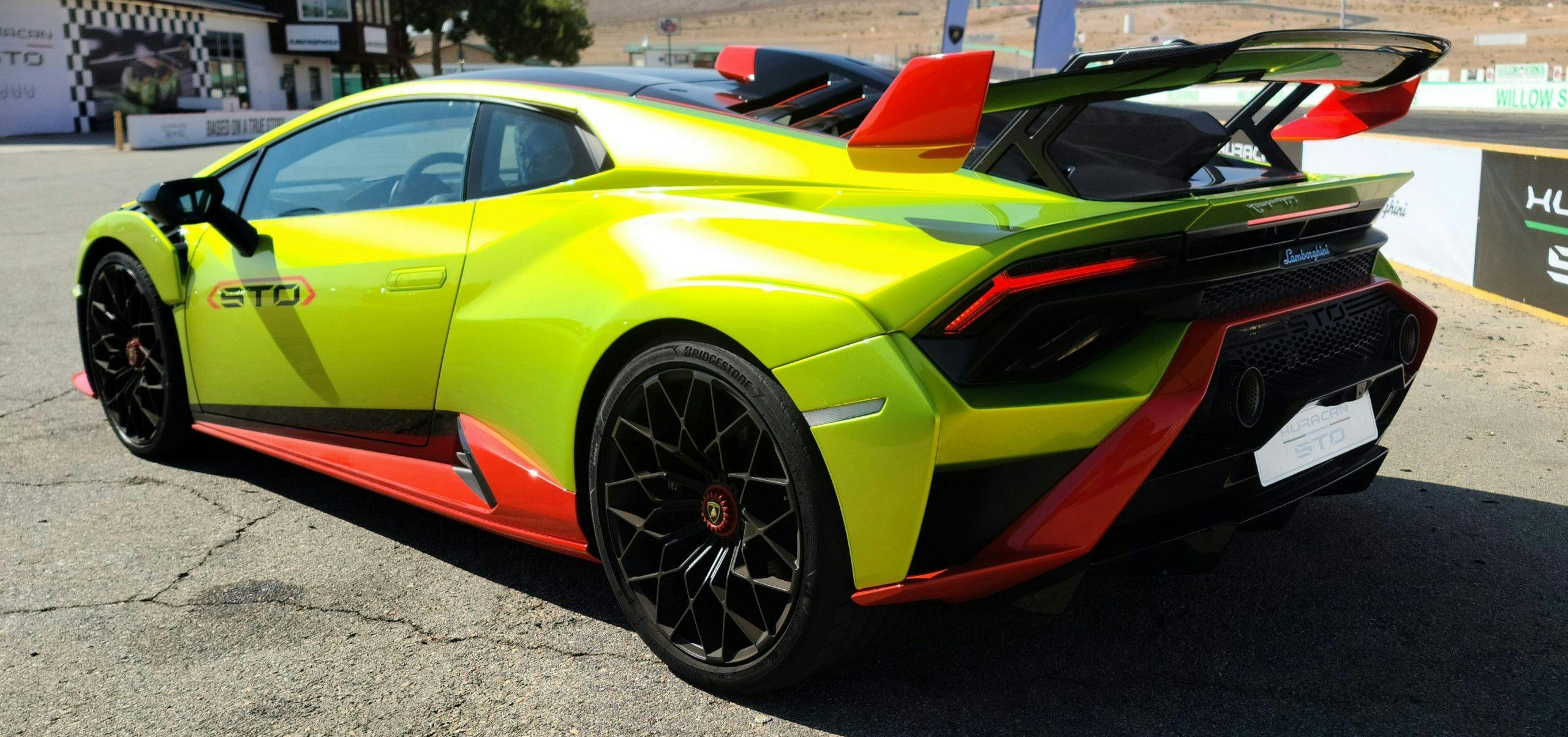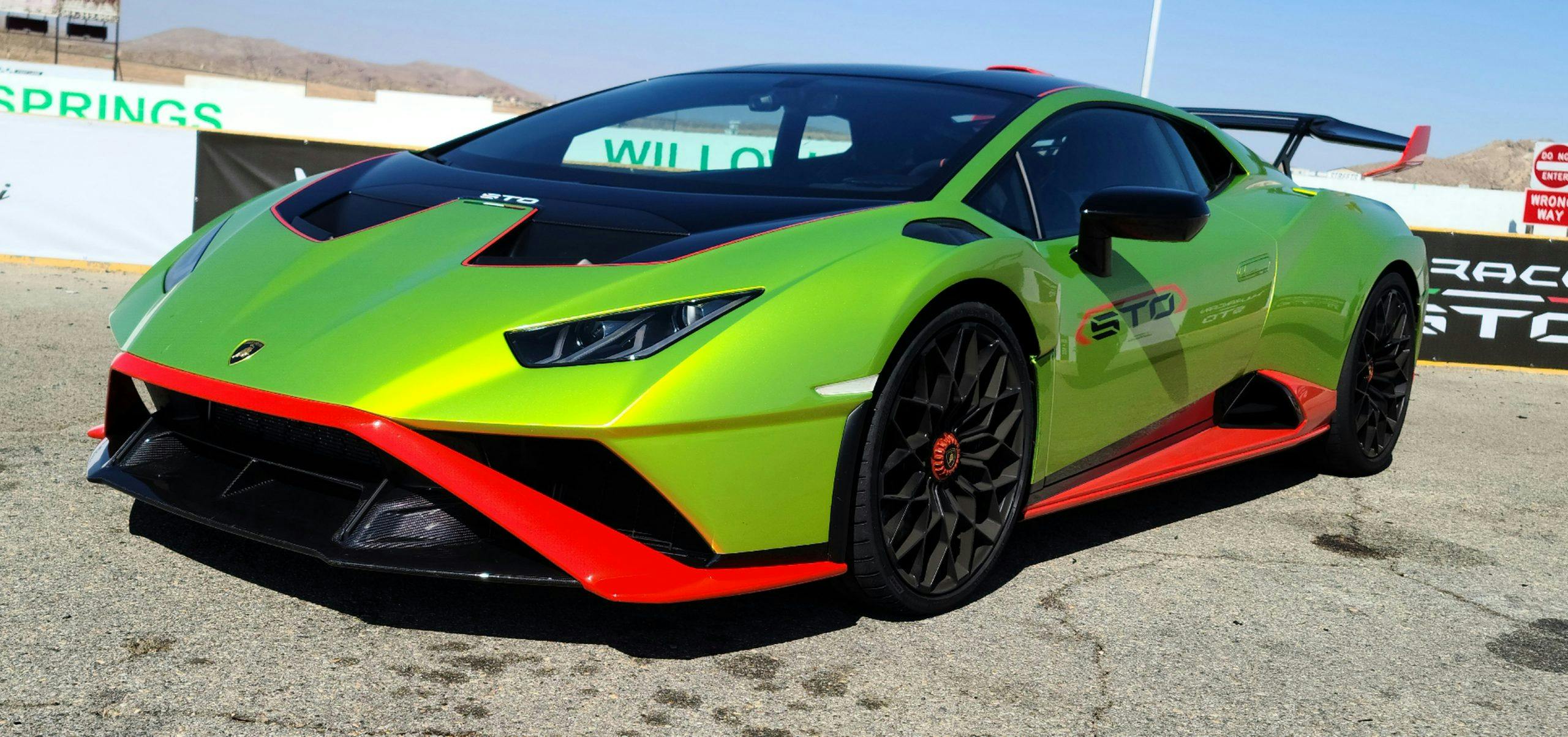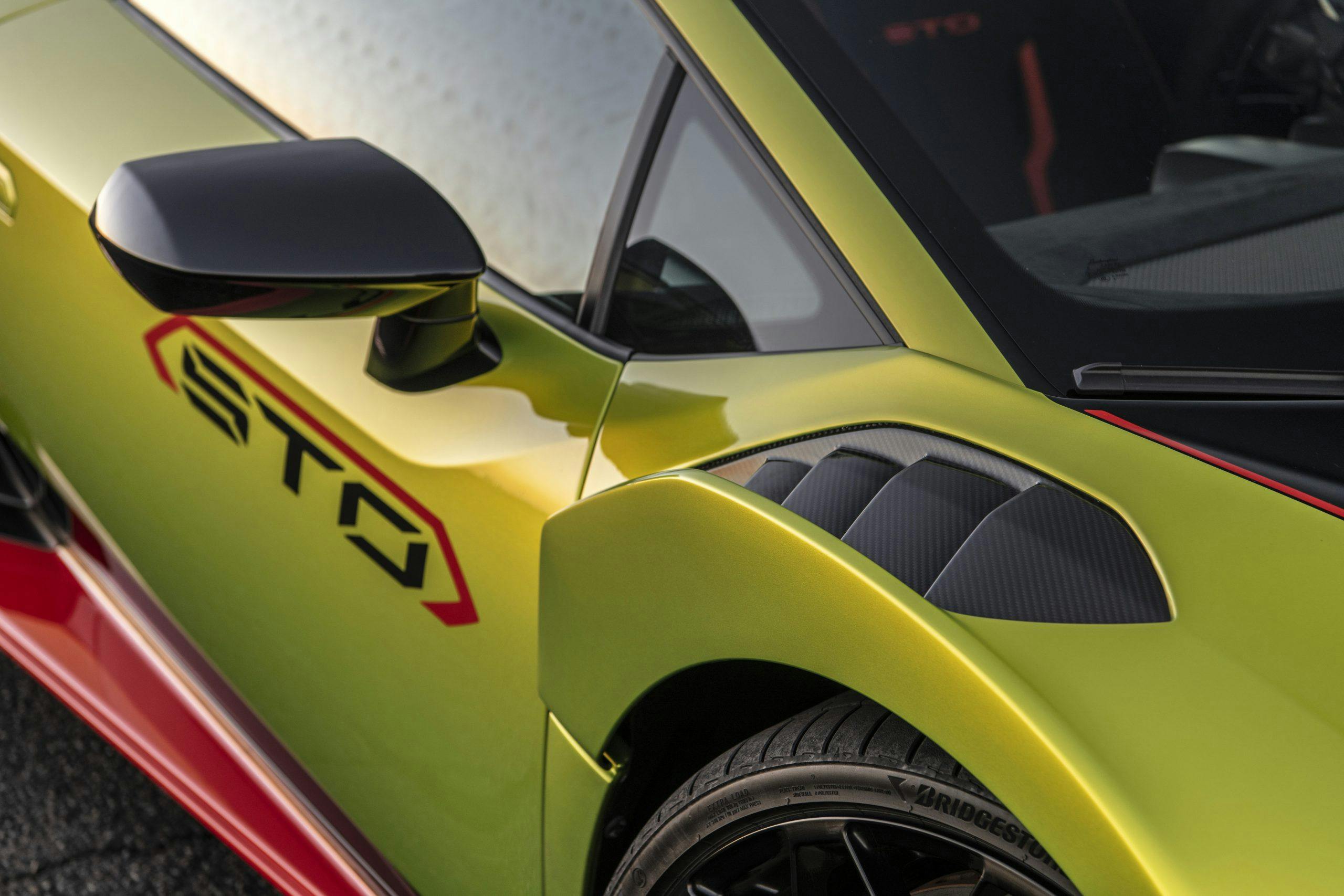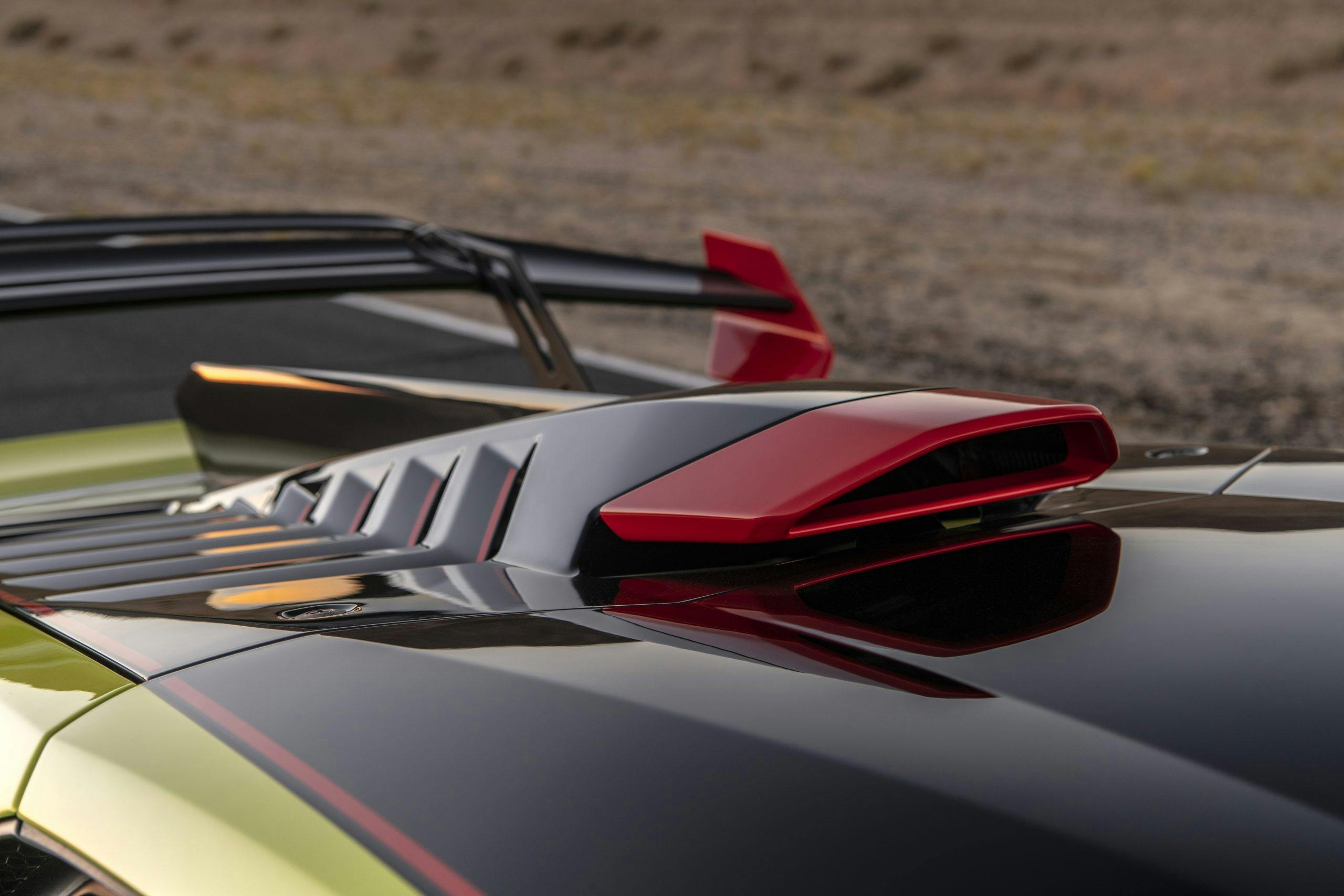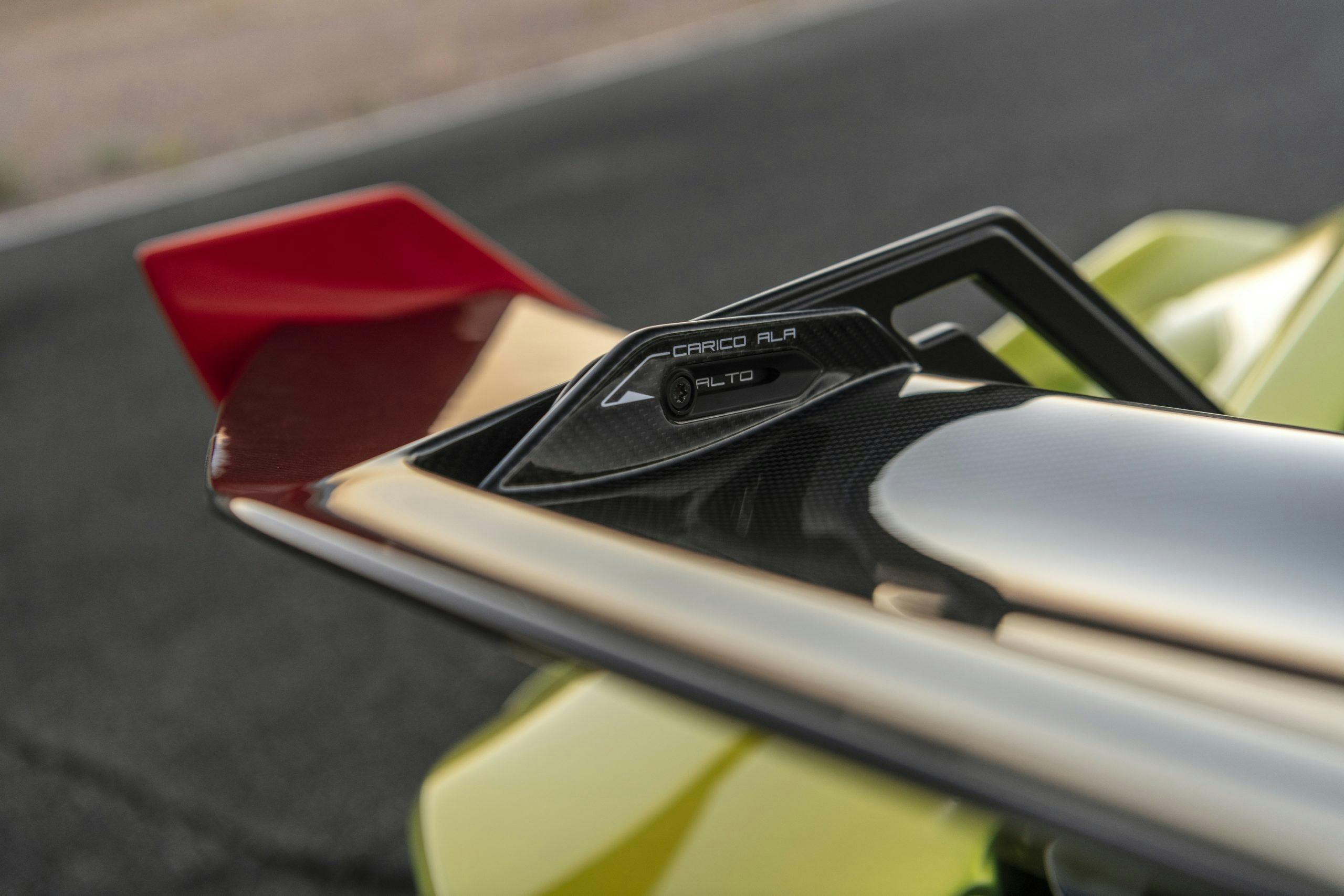First Look Review: 2022 Lamborghini Huracan STO
This has the potential to be a $660,000 mistake in just a matter of heartbeats. I’m at Willow Springs, it’s just over a hundred degrees outside, and ahead of me, Lamborghini factory driver (and, as of this writing, Super Trofeo series points leader) Richard Antinucci is just … slipping … down the backside of Turn Four. If he doesn’t catch some traction in the next two seconds, he’s going to be eating dirt. In just over half a second, I’m going to be where he is right now, and I have a choice: apply the same amount of throttle and set myself up for the same situation, or back off a touch. If I back off, and I’m right, I’ll keep us from becoming a two-car dust-up with the potential to utterly total two of the six Lamborghini Huracan STO supercars on hand for today’s event. But if I back off, and I’m wrong, then Antinucci will simply disappear from my windshield like the black Countach in the original Cannonball Run film.
Oh, well. It’s not my car, right?
More than that, I trust Antinucci implicitly, having driven with him as long ago as 2014. We’re the only two Americans to have stood on the podium at Sepang International Circuit; he won a big international GT-class race there, while I once took a dignified second in an amateur time trial featuring 1.6-liter Proton hatchbacks. (Basically the same accomplishment, as far as I’m concerned.) If Richard thinks the Huracan can find grip at the bottom of Four, then it probably can. The real question: Can I match his subtle and admirable ability to nurse this very big and very fast ten-cylinder wedge right at the limit of its bespoke-batch Bridgestone Potenza Race tires?

When Antinucci catches grip at the bottom of the hill then trail-brakes his Huracan into a wiggle-waggle direction change across the apex of Turn Five, I have the first part of my answer. Time to make sure my steering is completely unwound and wait for the same miracle to happen, at somewhere north of ninety miles per hour. And what do you know … the chunky wheel goes from dead to alive in my hands with just a few feet to spare, and I mimic what I’ve just seen with somewhat less aplomb, playing pitch-and-catch into Five before slapping the right paddle for an early change into fifth gear, settling the Huracan over the crest of Five. I’ve gifted Richard a full car length, an advantage I won’t recapture until I scrunch my eyes up and toss the car into the final turn with enough malice to make the suspension cycle almost all the way to the bump stops. Then we are off to the races down the front straight, crossing the start/finish line at just north of 149 mph.
On our next lap, I’m on pace to run a 1:29 when Antinucci flicks on his hazards and calls time on the session. Not exactly top-shelf time for Big Willow, but consider this: It was so hot, and the track was so green, that the back wheels were spinning under throttle in each of the first five gears. It was also just the second time in my life I’ve driven the track (the first time was in 2014) and my ninth lap of the day. Give me a morning to learn the track, and I could easily see running a 1:23 or thereabouts on fresh rubber, in cooler weather, with little concern for life or limb. This exceptionally exuberant Huracan has the power to make heroes out of everyday people; it’s possibly the most satisfying supercar to be found in showrooms this summer.
There’s just one little problem, but we’ll come back to that in a bit.
Lamborghini claims that this STO (Super Trofeo Omologato) has the same race-track pace as the Super Trofeo race car used in its intensely popular one-make race series, and almost as much as the Huracan GT3 that has enjoyed considerable success in mixed-class racing around the world. This is less outrageous than it sounds, since the Super Trofeo car isn’t that far away from the original street Huracan in most respects. To close the gap between the racer and the new omologato model, Lamborghini made a few very serious, and very expensive, additions. All of the bodywork is new, and most of it is carbon fiber. A one-piece carbon-fiber nose adds a tremendous amount of downforce—but God help you if you so much as brush it into a tire wall, it won’t be a cheap replacement. Brembo supplies their next-generation CCMR carbon-fiber brakes, claimed to have four times the thermal capacity of an equivalent steel system. “You won’t feel any change in the brakes over the course of your laps,” Lamborghini’s Maurizio Reggiani claimed, and he’s almost correct about that. (There’s a reason; we’ll come to that as well.)
The rear wing has a three-position manual adjustment; at the high-downforce setting, it’s claimed to put 900-ish pounds of pressure on the rear wheels at 175 mph or so. As a whole, the STO is almost a hundred pounds lighter than the previous Maximum Huracan, the Performante, allowing Lamborghini to claim a dry weight of just 2952 pounds. (In the real world, with fuel in it, I bet it’s close to 3150.) Bridgestone supplies two Huracan-specific tires, both called Potenza. The standard tire is an all-purpose street tire; the second is called simply Potenza Race. It’s intended to compete heads-up with the Michelin Pilot Sport Cup 2 found on many competing vehicles.
Your humble author has zero love for the “MPSC”—I think it’s a massively overrated status symbol for the Cars-and-Coffee crowd and inferior to at least the top five or six “Extreme Performance” tires you can get from Tire Rack—so how does Potenza Race stack up to the famous Bridgestone RE-71R, which is actually a great tire? In a conversation with Bridgestone engineers, I was told that the Potenza Race is optimized for long-run durability and consistent grip. The RE-71R, by contrast, is known for having a few “golden laps” in which it approaches the performance of DOT-R tires like the Hoosier R7, after which it settles down and becomes merely an excellent bit of rubber that, frankly, doesn’t like being abused at the far side of its limit and will punish you with a Hoosier-like release of grip if you turn in too aggressively.

Given the miserable temperatures at Willow Springs during our test, I can’t tell you how well the Potenza Race will grip in normal conditions. I can say that it is tolerant of abuse and that it cheerfully recovers from being overdriven in the space of just a couple turns, something that is very helpful when you’re trying to learn a race track in a 640-horse mid-engined automobile. The STO features rear-wheel steering and a comprehensively overhauled stability-control system; the former will help you turn and the latter will keep you from turning too much.
Since we’re in The Current Year, the STO features a few tech tricks as well. For the first time in any street car I’ve seen, you can monitor your brake temperature at all four corners. There’s also a super-sano system that relays live timing data to your smartphone and can provide multiple camera angles at the same time; it’s like the Corvette’s Performance Data Recorder system but more so, and far nicer-looking.
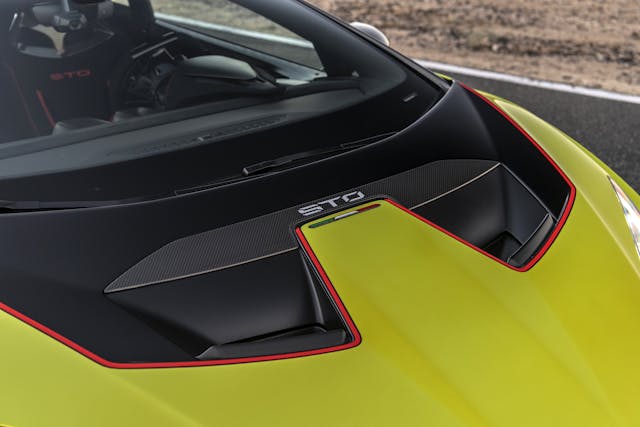
That’s all the stuff Lamborghini adds to the STO. Here’s what they remove: the front driveshaft. Unlike the previous alpha Huracan, the Performante, this is a two-wheel-drive car. Great, right? I mean, who wants all-wheel drive in a track-focused supercar?
Me, that’s who—and here’s why.
The old Performante was a subtle and thoroughly satisfying track rat, because it behaved like a RWD Huracan right up to the point where the rear tires were overwhelmed, at which point it would let the front axle pull the car straight. The amount of torque sent ahead of the driver was never very significant, but it was always welcome. As a consequence, the Performante was very easy to drive at outrageous pace right out of the box, even on unfamiliar tracks.
By contrast, the STO is always working the holy hell out of its rear tires. The car doesn’t have that much rubber to start with, with 245-width Potenzas up front and 305-width in back. Your humble author’s all-time-favorite streetable supercar, the outgoing Viper ACR, had 355-width rears. To put this in further perspective, my ex-World Challenge Honda Accord has 285-width Pirellis front and rear. It weighs about the same but has half the power. I think you see the issue, right? With the Performante, I was immediately comfortable disabling all stability and traction control to run against the clock. In the STO, I left the systems on.

Part of the problem was the extreme heat at Willow Springs, but even under better conditions I think this car will be continually asking quite a bit out of that relatively narrow rear rubber. My attempt to get around the track without letting the stability-control light flicker was depressingly tame; I had to be at least one gear higher than normal at all times. Exiting corners, particularly the uphill-and-downhill Turn 3/4/5 combo, required a feather-light touch on the throttle. The constant action demanded of the brakes by the traction-control system also denies them a chance to really cool off between corner entries, which does in fact produce a bit of brake fade by the third lap.
In the Super Trofeo race car, this isn’t a problem, because you get 305-width front and 315-width rear treadless slicks, using Pirelli’s outstanding DHA race compound. Under most circumstances, a Huracan ST-minus-the-O doesn’t feel like it’s short on grip. Nor is there much need for traction control when you have that kind of longitudinal grip on hand. Cut the widths down and make the rubber street-legal, and you’re going to perennially be at the edge of the tire. This is the same problem that affects virtually every McLaren made in the past decade, by the way. Not enough tire, especially not enough front tire, and unholy amounts of power delivered to the rear wheels at all times.
Therefore, I can’t say that the STO is an improvement over the outgoing Performante, which remains my favorite Huracan, Lamborghini, and Italian car of all time. Your mileage may vary. I wouldn’t blame you if it did. In the right conditions, and in the right hands, this new car is surely faster. It looks a lot more aggressive, which is always a good thing in Lamborghinis. Best of all, it represents an admirable defiance on the part of its maker; in his opening comments, Reggiani allowed that Lamborghini would be entirely hybrid-powered in the grim darkness of the Warhammer-40k-ish near future, but then brightened up and said, “For now, however, we will celebrate the natural aspiration.” For $327,838 plus personalization options, the Huracan STO is a lovely way to celebrate the natural aspiration. I personally aspire to own one, and so should anyone else with a pulse and a love of fine machinery. In a world of increasingly compromised “supercars,” Lamborghini is going out with the biggest bang possible. Feel free to buy two of them, if you can afford to; it would be the precise opposite of a $660,000 mistake.

